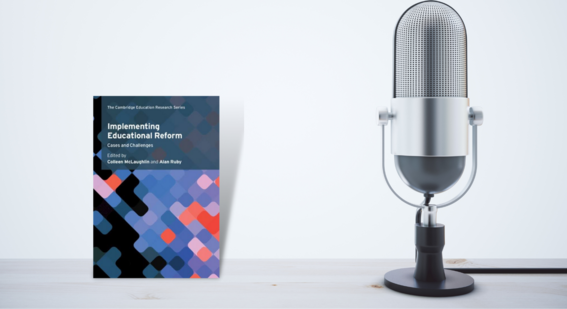Connecting and Linking - teacher education reform, scale, and change
In this post, Professor Colleen McLaughlin explores some of the key questions to help us think about teacher development.

Many factors affect student learning but one of the most powerful is the teacher. Teachers are the cornerstone of our education systems and the central unit of the teacher and the classroom, whatever that looks like, is the most important part of the whole system. The quality of teaching has been described as the most significant lever in achieving positive outcomes for students. Teacher learning and development is inextricably linked to the quality of teaching and the experience of student learning.
Competition on the global PISA stage has also meant that policy makers eagerly engage with reform and want it to be ‘at scale’. An understandable ambition, the greatest good for the greatest number. The search for the perfect system or answer is a perpetual one. In this short piece, I explore some of the key questions to help us think about teacher development, what are its important qualities if it is to be effective, and how these might be addressed. I will do this by drawing on recent evidence in this area, so that we can have confidence in the statements made.
Why focus on the Continuing Professional Development and Learning (CPDL) of teachers?
Just providing opportunities for teacher learning is not enough. We have evidence that it can be both a stimulus to school improvement and better student outcomes, and can have little impact at all. Darling Hammond et al (2015) define effective professional development as 'structured professional learning that results in changes in teacher practices and improvements in student learning outcomes'. Recently researchers have begun to try to measure the impact of CPDL. A 2020 study of teachers’ professional development gives us confidence in recent statements that the quality of education is impacted upon by professional development. The 2020 EPI study showed that CPDL was effective in impacting upon students learning and estimated that the average size effect was 0.9, ‘which compares favourably to other educational interventions (for example, comprehensive school reform models achieve effect sizes between 0.1 and 0.2).’ The study found that effective CPDL can lead to increased student self-efficacy and confidence’ as well as increasing teacher retention. These are important statements for it means that there is strong justification for policy makers to invest in CPDL as a highly effective way of improving the quality of student learning as well as retaining and improving the teacher workforce.
What do we know about the nature of effective CPDL?
This section is based on findings from the key studies listed below, which I have synthesised under the following headings.
- H. Timperley, A. Wilson, H. Barrar & I. Fung (2007) Teacher Professional Learning and Development: Best Evidence Synthesis Iteration Wellington, New Zealand: Ministry of Education. Downloadable for free at: https://www.oecd.org/education/school/48727127.pdf
- Cordingley, P., Higgins, S., Coe, R., Greany, T., Buckler, N., Coles-Jordan, D., Crisp, B., & Saunders, L. (2015). Developing Great Teaching: Lessons from the international reviews into effective professional development. Teacher Development Trust. https://tdtrust.org/wp-content/uploads/2015/10/DGT-Full-report.pdf
- Darling-Hammond, L., Hyler, M. E., Gardner, M. (2017). Effective Teacher Professional Development. Palo Alto, CA: Learning Policy Institute. https://learningpolicyinstitute.org/product/teacher-prof-dev.
Context and Enabling Conditions
If the seeds of teacher learning are to flourish, then the soil into which they are planted will dictate what grows and the impact. In our own and others research the creation of the conditions for teacher learning is a crucial function. It involves the following:
- Establishing the conditions for professional learning communities and collaboration. If teachers have no resources allocated to CPDL and no space to meet and talk, little is possible. Leaders need to create spaces in allocated teacher time for collaboration and teachers should not be punished for it e.g., not be paid for doing this work. Sufficient time must be allowed and there needs to be consistency of fit between the social and education context the teachers inhabit, and the learning required.
- Provide sustained opportunities to learn and with realistic time expectations. Teacher professional learning is highly complex and requires supportive and sustained leadership and nurturing. Most effective programmes were a minimum of two terms and often many years. The crucial element however is what the time is used for.
- Sustainability means that there needs to be planned ongoing support and follow up.
- Align school and district conditions to the aim of the CPDL. This involves analysing the supporting and blocking existing practices and policies.
Leadership
Leaders must establish the conditions before the CPDL starts, for when it does one of the most important processes that occurs is the creation of a common sense of purpose. Leaders themselves need to have a clear sense of purpose, as well as establishing that the CPDL is relevant, and time is well used.
Nature of the experience
There is now considerable agreement on the key factors in the experience of professional development that teachers need to receive if it is to have impact. Darling Hammond (2017) concluded there were seven common and shared features.
- It is content focused. Attention to discipline focus is important. Generic pedagogic training needs to focus on content too.
- Active learning needs to be incorporated. This involves teachers in designing activities and experiencing the model of pedagogy being advocated. Attention and opportunity for application is key.
- Collaboration is supported and integrated into the model of working
- Models of effective practice need to provide a vision and exemplars
- Coaching and effective support must be provided, and many studies emphasise the inclusion of outside expertise, but not this alone.
- There must be opportunities for feedback and reflection
- Provide sufficient and sustained time
What is very clear is that there is no ‘one size fits all’ but attention to the specific context and to the application of these factors will warrant greater impact.
Linking and Connecting
The research we have examined places requirements on teachers, school leaders and policy makers. These are about linking and connecting processes, people, and programmes. There needs to be a conception of teacher learning as a career long process with links between initial teacher education and continuing professional development. This also involves creating the expectation of continual learning and embedding it into teacher identity.
The processes of teacher learning need to be connected to the real world of teaching and learning; accordingly, they must be relevant, but they must also be based on systematic needs assessment. The CPDL must engaged with the dilemmas and complexities of applying the proposed practices and attitudes. It must be fit for context. These need to be built in. We need to link practitioners to each other to release the power of collaboration. Successful implementation of teacher professional development may involve redesigning the condition of teachers’ work including time and school schedules, and it places responsibility for policy makers to have heed to the reality of their expectation and especially if there is to be good use of scarce resources. Darling Hammond argues for the setting of clear standards for teachers, so there can be alignment. These are long term projects. Successful scaling up involves the application of these principles and factors. Systems that have paid attention to these elements have been successful.
Colleen McLaughlin, Professor Emerita at the University of Cambridge, is now an independent researcher. She has held various positions at Cambridge: Special Advisor; the Director of Education Innovation at the Faculty of Education; Deputy Head of Faculty; and Head of Dept at the University of Sussex. She has worked with governments on education reform in many international contexts. Her professional and research interests are education reform, teacher development, mental health and the school’s role, as well as school university research partnerships. .
A new book edited by Colleen McLaughlin and Alan Ruby, ‘Implementing Educational Reform’ will be published on 18th November.
You can listen to Colleen and Alan discuss implementation in this first podcast episode about the book:



